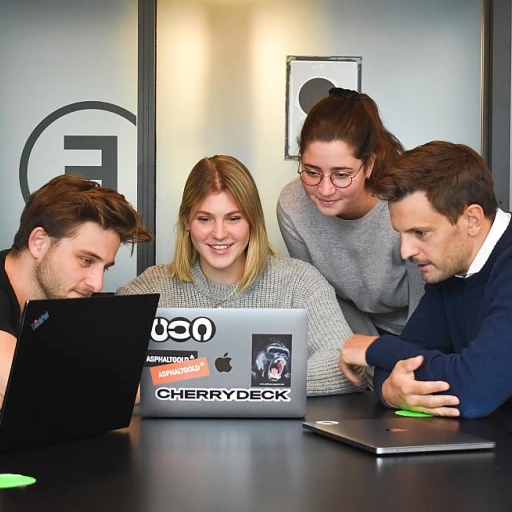Revolutionizing Team Dynamics
The landscape of collaboration tools is undergoing a profound transformation, fundamentally altering how teams operate and interact. These tools are no longer confined to basic functions like file sharing or instant messaging. They have evolved into sophisticated platforms that foster creativity, streamline communication, and enhance productivity. As we stand on the cusp of this digital evolution, understanding the impact of these tools is crucial for staying ahead in the dynamic world of work.
A significant factor driving this change is the increased reliance on distributed teams. Digital collaboration tools are bridging geographical gaps, enabling seamless interaction regardless of location. They provide a virtual workspace where ideas can flow freely and projects can move forward with remarkable efficiency, a trend we continue to explore in
the future of working remotely.
Moreover, artificial intelligence is playing an instrumental role in refining collaboration tools. AI-powered features, such as real-time translation, project management automation, and personalized insights, are empowering teams to work smarter, not harder. By leveraging these technologies, businesses are not only enhancing team dynamics but also unlocking new levels of innovation.
Looking forward, the integration of cloud technology and advancements in augmented and virtual reality will likely redefine the boundaries of teamwork further. These innovations promise to create fully immersive, yet flexible, virtual work environments. As such, the possibilities for the future are only limited by our imagination and willingness to embrace these powerful tools. The role of data analysis in refining and adapting collaboration tools will be particularly critical, ensuring they are tailored to meet the ever-evolving needs of the modern workforce.
Remote Work and the Rise of Digital Collaboration
Digital Tools Paving the Way for Remote Work
In recent years, the transformation of collaboration tools has been nothing short of revolutionary. As remote work becomes increasingly prevalent, digital collaboration tools are playing a pivotal role in redefining how we work together from afar. Before, the idea of working from home was a mere fantasy for many, but now, it is rapidly becoming a reality thanks to advances in technology.
The landscape of remote work has evolved far beyond simple video calls and shared documents. Today's collaboration platforms offer comprehensive sets of features that facilitate communication, project management, and team engagement, making it easier to maintain productivity from any location. Features like real-time data sharing, integrated task management, and seamless communication channels are empowering remote teams to operate as effectively as those working in traditional office settings.
One significant advantage of these tools is the ability to break down geographic barriers, allowing companies to tap into a global talent pool. As businesses adapt to this shift, they're discovering that the potential for boosting efficiency through remote work is tremendous. In fact, many organizations report increased productivity and faster problem-solving when teams utilize these advanced collaborative solutions.
For those interested in understanding how these trends are reshaping productivity, our partner blog offers insights into
boosting efficiency through remote work.
As digital collaboration tools continue to evolve, they are not only enhancing remote work experiences but are also setting the stage for future innovations. As we explore further into aspects like teamwork in the cloud and the integration of augmented reality, it's clear that technology will continue to redefine the possibilities of remote collaboration.
Teamwork in the Cloud: The New Normal
Harnessing the Power of the Cloud for Seamless Teamwork
In our rapidly evolving world, cloud-based collaboration tools are emerging as a linchpin for organizational success. With the digital landscape empowering remote work, the reliance on cloud technology is becoming engrained in the fabric of teamwork dynamics. The flexibility and scalability offered by these tools are unparalleled, providing the infrastructure for a truly connected global workforce.
Teamwork in the cloud signifies more than just storing files online. It encompasses a suite of applications where efficiency, communication, and productivity thrive without the limitations of physical offices. Tools like Google Workspace, Microsoft Teams, and Slack embody this transition, enabling real-time collaboration and seamless interaction regardless of where team members are located. This transformation is crucial as businesses navigate new challenges posed by decentralization, striving to maintain the level of connectivity and synchronicity that once defined in-person settings.
One of the remarkable advantages of cloud collaboration tools is their ability to facilitate harmonious teamwork across different time zones. For instance, asynchronous communication becomes a straightforward process, allowing team members to contribute on their own schedules while remaining in sync with their colleagues' progress. This adaptability is vital in today's global economy, where diverse teams are spread across continents and time zones.
However, its impact extends further than just communication. Cloud technology also supports the integration of artificial intelligence (AI) and machine learning algorithms, enhancing the functionality of collaboration tools. These intelligent systems can streamline project management by predicting potential roadblocks, suggesting optimal workflows, and even facilitating language translation for international teams, thus breaking down barriers to efficiency and innovation.
For businesses and collaborators embracing the future of work, adopting cloud-based solutions is no longer optional but essential. The evolution of these tools is set to redefine productivity coupled with technological advancements in augmented and virtual reality, as outlined earlier, opening new avenues for immersive remote collaboration. Companies aiming to adapt to this new reality must truly consider the transformative potential cloud collaboration offers, preparing themselves for a hyper-connected, efficient, and innovative future workforce.
For a deeper dive into how these shifts are solidifying the gig economy and influencing conventional work models, explore the
emerging shifts in today's work landscape.
Augmented and Virtual Reality: The Next Frontier
Exploring the Potential of Augmented and Virtual Reality in Collaboration
As we consider the evolution of collaboration tools, a new set of technologies is beginning to reshape how teams interact: augmented reality (AR) and virtual reality (VR). These innovations promise to elevate team collaboration beyond the limitations of traditional platforms, offering immersive environments that simulate face-to-face interactions in a digital space.
The introduction of AR and VR into the workspace is not merely about replacing video conferencing; it is about enhancing it with dimensions of presence and interactivity that were previously unimaginable. Imagine virtual meetings where participants are represented by 3D avatars in a shared digital environment, allowing for a level of engagement that is far more natural and intuitive compared to standard screen sharing. Such a setup could greatly enhance the quality of communication and understanding among team members.
AR, in particular, brings a unique aspect to the table by allowing the overlay of digital information onto the real world. This capability is especially transformative for industries where hands-on collaboration and visualization are critical, such as architecture, engineering, and design. With AR, team members can work together on physical prototypes, visualizing potential changes in real-time without being restricted by geographical boundaries.
In discussing remote work and digital collaboration, it's clear that the physical distance between team members has become less of a barrier. AR and VR promise to close this gap even further by providing the tools for a simulated proximity that fosters collaboration. This level of innovation highlights how digital collaboration methods are continuously being redefined, setting the stage for even broader applications in the future.
The movement towards incorporating AR and VR in collaboration tools is still in its nascent stage, and more development is necessary to address challenges such as hardware costs, user interface designs, and accessibility. However, the potential is immense, promising an exciting and interactive future for teamwork as these technologies become increasingly integrated into our daily work lives.
Data-Driven Collaboration: Enhancing Efficiency and Insight
In the ever-evolving landscape of teamwork tools, data has emerged as a pivotal force shaping the way we collaborate. As organizations increasingly rely on digital platforms to facilitate communication and project management, the wealth of data generated offers unprecedented opportunities to enhance efficiency and provide valuable insights.
Data analytics within collaboration tools can help teams identify patterns and trends that might otherwise go unnoticed. By analyzing communication flows, task completion rates, and project timelines, organizations can pinpoint bottlenecks and areas for improvement. This not only streamlines workflows but also empowers teams to make informed decisions, ultimately driving productivity.
Moreover, as explored in our discussion on the rise of digital collaboration, remote work has accelerated the adoption of cloud-based tools, which inherently generate and store vast amounts of data. This data, when harnessed effectively, can foster a more agile and responsive work environment, allowing teams to adapt quickly to changing circumstances.
Privacy and data security remain paramount concerns, however. As collaboration tools evolve to leverage data analytics, ensuring that sensitive information is protected is crucial. Companies must strike a balance between utilizing data to enhance collaboration and safeguarding the privacy of their employees.
In conclusion, the integration of data into collaboration tools is not just a trend but a transformative shift. By embracing data-driven strategies, organizations can unlock new levels of teamwork and innovation, paving the way for a more connected and efficient future.
Global Perspectives: Collaboration Trends Around the World
Collaboration Tools from a Global Perspective
As we witness the evolution of collaboration tools transforming teamwork dynamics, it is crucial to consider the global landscape and how different cultural contexts are shaping these trends. In various parts of the world, the way collaboration tools are adopted and adapted reflects diverse business needs and cultural nuances.
In Europe, there's a strong emphasis on privacy and data protection, which extensively influences the choice of collaboration tools. Organizations are favoring platforms that comply with stringent data regulations like GDPR, ensuring that collaboration is not only efficient but also secure.
Across Asia, particularly in countries like Japan and South Korea, there is an innovative push towards integrating AI and automation in digital collaboration. These advancements are tailored to increase productivity while respecting the traditional value placed on collective decision-making processes. Such a blend of technology and culture ensures a smooth transition to digital platforms while maintaining harmony within team dynamics.
Meanwhile, in North America, the focus has been on flexible work solutions to foster inclusivity and accessibility. The rise of digital collaboration in these regions often prioritizes interoperability among multiple tools from different vendors, supporting fluid and dynamic work environments.
In regions like Africa and Latin America, where remote work is increasingly part of the business vernacular, mobile-first collaboration tools are gaining traction. This meets the growing need for connectivity and access even in areas with limited infrastructure while promoting inclusive growth and engagement.
These global trends reflect the diverse ways in which collaboration tools are embraced, driven by specific regional drivers but culminating in a more interconnected and collaborative global work environment. As technology continues to redefine collaboration, understanding these global perspectives is key to fostering inclusive and effective teamwork across borders.












